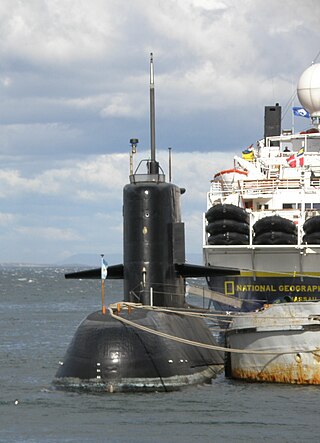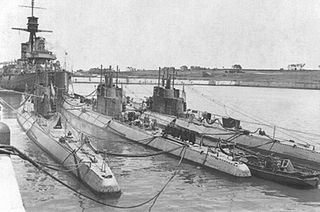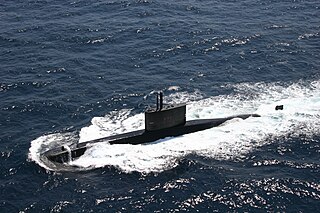
The Brazilian Navy is the naval service branch of the Brazilian Armed Forces, responsible for conducting naval operations. The Brazilian Navy is the largest navy in Latin America and the second largest navy in the Americas after the United States Navy.
Navantia is a Spanish state-owned shipbuilding company, which offers its services to both military and civil sectors. It is the fifth-largest shipbuilder in Europe and the ninth-largest in the world with shipyards around the globe. The heir to the segregation of the military assets of the IZAR Group in 2005, Navantia designs, builds and supports all types of surface vessels, submarines and systems. In addition, it is expanding into new markets diversifying its product, such as renewable energy, the offshore industry and all kinds of services that it requires by the naval industry.

The Scorpène-class submarines are a class of diesel-electric attack submarines jointly developed by the French Naval Group and the Spanish company Navantia. It features diesel propulsion and an additional air-independent propulsion (AIP). It is now marketed as the Scorpène 2000.

The Type 209 is a range of diesel-electric attack submarines developed exclusively for export by Howaldtswerke-Deutsche Werft of Germany. Five class variants, including modifications thereof, have been successfully exported to 15 countries, with 90 submarines being built and commissioned between 1971 and 2021.

The TR-1700 is a class of diesel-electric patrol submarines built by Thyssen Nordseewerke for the Argentine Navy in the 1980s, with two submarines completed. These ships are amongst the largest submarines built in Germany since World War II and are among the fastest diesel-electric submarines in the world. ARA San Juan was lost on 17 November 2017, leaving ARA Santa Cruz as the only remaining submarine of this class. As of 2020, the refit of Santa Cruz has been reported cancelled leaving the entire class inactive.

The Combat Divers Groupment, abbreviated to GRUMEC, is a special operations and Counterterrorism unit of the Brazilian Navy.

S Tikuna (S-34) is a Type 209 submarine of the Brazilian Navy. Built in the Brazilian Navy Yard in Rio de Janeiro (AMRJ), it was launched in March 2005 and incorporated into the Brazilian Navy on July 21, 2006, and then transferred to the Naval Operations Command. It is the fourth Brazilian Navy submarine made in Brazil and the largest ever built in the country. The name of this submarine is a tribute to South American indigenous tribe Tikuna inhabiting the region of the Upper Solimões, in the western part of the State of Amazonas.

The Arsenal de Marinha do Rio de Janeiro (AMRJ) is a military organization of the Brazilian Navy. It is located in Ilha das Cobras, at the Guanabara Bay, in the city of Rio de Janeiro. The Arsenal is the main maintenance center and naval base of the Brazilian Navy, involving the design, construction and maintenance of ships and submarines, not only for the Brazilian Navy, but also friendly nations.

ARA Santa Cruz (S-41) is a member of the TR-1700 class of diesel-electric submarines of the Argentine Navy.

The Santa Fe-class submarines, also known as the Tarantinos after the city in which they were built, were a class of three pre-World War II submarines, designed and built in Italy in 1928-1933, as part of an Argentine expansion plan for its navy. They were in service with the Argentine Navy from the early 1930s to the late 1950s. The class was named after Argentine provinces starting with “S”, as traditional in the Argentine Navy.

Álvaro Alberto the Brazil's first nuclear-powered attack submarine, is part of a strategic partnership signed between France and Brazil on 23 December 2008 by then-presidents Luiz Inácio Lula da Silva and Nicolas Sarkozy, that created the Submarine Development Program, a naval modernization plan of the Brazilian Armed Forces. The boat is the fifth unit of the Riachuelo-class, based on the French Scorpène-class. The submarine is being constructed by the Brazilian state-owned naval company ICN.

Humaitá (S41) is a Brazilian Riachuelo-class submarine built for the Brazilian Navy by ICN in Itaguaí, and DCNS.

The Itaguaí Construções Navais S.A. known as ICN, is a Brazilian state-owned defence company specialized in naval-based platforms and naval nuclear engineering, founded on 21 August 2009. The company employs nearly to 2.000 people.
The Brazilian Submarine Force Command, is the submarine force of the Brazilian Navy. The ComForS is one of the oldest commands of the Brazilian Armed Forces.

S Tamoio(S-31) was the second Tupi-class submarine of the Brazilian Navy.

S Tapajó(S-33) was the fourth boat of the Tupi-class submarine of the Brazilian Navy.

The Foca class, or simply F, was the first naval class of submarines operated by the Brazilian Navy. It consisted of the F1, F3 and F5 submarines designed by Italian naval engineer Cesare Laurenti and built in La Spezia, Italy. The name Foca comes from the Portuguese vessel of the class. The class was part of Brazil's 1906 naval program to acquire warships to modernize its navy. The submarines were acquired to serve as a training and maintenance platform for the crews, with few naval actions during the 19 years they were active. The navy incorporated the class on 17 July 1914 and, as a result, expanded its naval structure to house these new vessels, such as the creation of the first naval school for submariners and the incorporation of ships designed to support submarines only.

The Submarine Development Program (PROSUB) is a partnership signed between Brazil and France in 2008, with the objective of transferring technology for the manufacture of military vessels. It is a component of the Brazil's Defense Strategy to develop the country's naval power with the production of four conventional submarines and the first Brazilian nuclear-powered submarine. The program will make Brazil one of the few countries to have nuclear technology, alongside the United States, Russia, France, the United Kingdom, China, and India.

The Riachuelo class are a Brazilian class of diesel-electric and nuclear-powered attack submarines developed by the state-owned shipyard Itaguaí Construções Navais, based on the French Scorpène class as part of the Submarine Development Program (PROSUB), a naval modernization plan of the Brazilian Armed Forces.




















